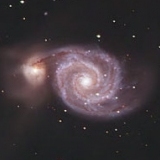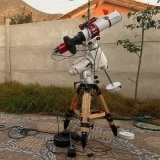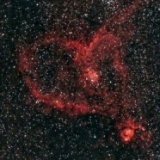INDI Library v2.0.7 is Released (01 Apr 2024)
Bi-monthly release with minor bug fixes and improvements
What good does an iOptron iPolar scope/camera do for an Ekos user?
- Rick Wayne
-
 Topic Author
Topic Author
- Offline
- Elite Member
-

- Posts: 222
- Thank you received: 20
Replied by Rick Wayne on topic What good does an iOptron iPolar scope/camera do for an Ekos user?
Holy cow! Now the 6 million dollar question jumps to mind: Which was correct, Ekos or the iPolar? I know I've had issues getting my PA to converge using Ekos (rerun the sequence and the alignment is still off or worse), and other times when I've gotten repeatable, single-digit arcseconds results with Ekos PAA, I run the PHD guiding assistant it tells me I have several minutes of error. Unfortunately I'm rarely in a position, or have the patience, to do a real live drift alignment to be certain.
Please Log in or Create an account to join the conversation.
- Scott Denning
-

- Offline
- Elite Member
-

- Posts: 300
- Thank you received: 57
Replied by Scott Denning on topic What good does an iOptron iPolar scope/camera do for an Ekos user?
Think of a polar scope, the Ekos/Sharpcap routines, or the iPolar program as a quick and simple approximation.
Drift alignment in PHD2 is going to be better, but is still just a sample of the many possible measurements.
The "best" position of the polar axis for long-exposure imaging will be given by optimizing a mount model against dozens to hundreds of measurements across as much of the sky as possible. But for most applications the quick-and-dirty methods work just fine.
Please Log in or Create an account to join the conversation.
- Rick Wayne
-
 Topic Author
Topic Author
- Offline
- Elite Member
-

- Posts: 222
- Thank you received: 20
Replied by Rick Wayne on topic What good does an iOptron iPolar scope/camera do for an Ekos user?
Wouter, I'm not sure I read your post correctly. Did you intend to say 40 minutes of arc? If it were 40 seconds I'd be intrigued, but probably shrug it off. 40 minutes...that's some real Tennessee windage you're talkin', there!
Please Log in or Create an account to join the conversation.
- Wouter van Reeven
-

- Offline
- Supernova Explorer
-

- Posts: 1957
- Thank you received: 420
Replied by Wouter van Reeven on topic What good does an iOptron iPolar scope/camera do for an Ekos user?
Wouter
Please Log in or Create an account to join the conversation.
- Jose Corazon
-

- Offline
- Supernova Explorer
-

- Posts: 1119
- Thank you received: 182
Replied by Jose Corazon on topic What good does an iOptron iPolar scope/camera do for an Ekos user?
Even with the best level, I don't see it being possible to level out the mount to <30' accuracy. In the end, you would spend a LOT more time trying to level out the mount to the required accuracy than the rotations in Ekos take.
I don't even level out my mount anymore, I have it roughly level and let the PA routine do the rest.
I routinely end up with <2' PA accuracy using a polemaster (with the Ekos PA routine) and that is borne out by the drift analysis I can retrieve from the PHD2 log file at the end of the session (although I am not using PHD2, but exclusively the internal guider).
Jo
Please Log in or Create an account to join the conversation.
- Rick Wayne
-
 Topic Author
Topic Author
- Offline
- Elite Member
-

- Posts: 222
- Thank you received: 20
Replied by Rick Wayne on topic What good does an iOptron iPolar scope/camera do for an Ekos user?
Yikes. Do you know which was correct?
Please Log in or Create an account to join the conversation.
- Rick Wayne
-
 Topic Author
Topic Author
- Offline
- Elite Member
-

- Posts: 222
- Thank you received: 20
Replied by Rick Wayne on topic What good does an iOptron iPolar scope/camera do for an Ekos user?
I freely admit that I may be wrong -- I have the worst spatial intelligence of anyone I know (even our cats).
Please Log in or Create an account to join the conversation.
- Jose Corazon
-

- Offline
- Supernova Explorer
-

- Posts: 1119
- Thank you received: 182
Replied by Jose Corazon on topic What good does an iOptron iPolar scope/camera do for an Ekos user?
Let's say, you align perfectly tonight, tomorrow you set up your mount again, but now the ground is soggy and one tripod leg ends up lower than the other, tilting the mount by 1 or 2 degrees.
Everything else being equal, how would iPolar know that mount is not level or the camera rotation angle has changed, etc?
If the coordinate system remains identical, then, yes, it would work, but if the coordinate system has changed, I cannot see how iPolar would solve that problem with one variable too many. Accounting for that 3rd variable is the entire reason for rotating the mount for PA determination in Ekos.
Please correct me if I am wrong here.
Please Log in or Create an account to join the conversation.
- Rick Wayne
-
 Topic Author
Topic Author
- Offline
- Elite Member
-

- Posts: 222
- Thank you received: 20
Replied by Rick Wayne on topic What good does an iOptron iPolar scope/camera do for an Ekos user?
But after calibration, the camera/computer/gadget has a model of its relationship to the RA axis, and that only changes if the camera in the axis gets bumped.
And by shooting a picture and plate solving it, it can see that, whoops, it's not pointing in the right place anymore. Now, if the soggitudinousness merely rotated the entire mount perfectly around the RA axis, certainly iPolar wouldn't know that, since it doesn't have a mount model per se. So your GOTOs would be off. But your polar alignment would still be awesome.
Please Log in or Create an account to join the conversation.
- Kurt Lanes
-

- Offline
- Premium Member
-

- Posts: 115
- Thank you received: 7
Replied by Kurt Lanes on topic What good does an iOptron iPolar scope/camera do for an Ekos user?
I would really like to do what you are doing an have been trying for a week or more. Is there any way you could give me a few pointers on your EKOS setup. I tried to run my CEM40G from Kstars on Astroberry but I couldn’t ever get iPolar to even connect to the camera. Perhaps a screen shot or 2. My guide camera comes up when iPolar is selected and no other way. It actually works but I havn’t been able to focus it yet. Also after 3 nights of driving the CEM40 it quit with a /dev/ttyUSB1 no such device error. I no longer works.
Kurt
Please Log in or Create an account to join the conversation.
Replied by Martha on topic What good does an iOptron iPolar scope/camera do for an Ekos user?
I am the ATM enthusiast, who built some astro stuff, including equatorial fork mount for my 10" OTA, ready for 70+kg load. I found, that the leveling the tripod (or a base in my case) is important for an ease of the polar alignment, but not essential, if you are going to do the polar alignment anyway. In general, in a range of reasonable positions, there is always possible to lift or lower the wedge and move it left or right enough, to aim the NCP, regardless the leveling. Thus I ask, why the "leveling" appears here so many time? Is it because of the GoTo? As long as the RA axis is aimed at the NCP (SCP...), the PHD(2) must work good and the long time exposures must be sharp. Am I right? I spoke with some astro photographers, they agree with me that they don't perform the multi-star alignment since they have the astrometry/plate solve. I know that it should be performed to build the model, but is it really essential?
I have also the iPolar camera and I think it's good enough to aim the mount roughly, but the Drift Align or other methods of obtaining the proper alignment should be performed anyway. Moreover, the iPolar is good enough for the astrophotography by short focal length OTAs, but isn't for 2500mm or more, where I am aiming.
I'll be happy to know your opinion.
Tomasz.
Please Log in or Create an account to join the conversation.
- Rick Wayne
-
 Topic Author
Topic Author
- Offline
- Elite Member
-

- Posts: 222
- Thank you received: 20
Replied by Rick Wayne on topic What good does an iOptron iPolar scope/camera do for an Ekos user?
WRT the question of leveling or precise zero position, I can state categorically that leveling does not matter to iPolar. The key difference is that the camera is bolted into the axis, and so calibrating it yields a durable measurement of its displacement from that axis. Doesn't matter how you point or level the mount, because it's not attempting to decompose azimuth and altitude guidance. Unless the camera's alignment changes, the cross (representing the polar axis) will always be in the same pixel of the image. Plate solving lets it depict the dot (celestial pole) precisely. Superimpose the two and you're aligned.
Not willing to go as far out on a limb regarding zero position. But the CEM70 has a "find zero position" command which hunts in both RA and DEC until it's located -- I assume to a reasonable level of precision.
Having used it, now I understand one significant advantage iPolar possesses over Ekos PAA: since it's a wide-field camera, even if you just roughly eyeball the Pole, the target will be in the camera's FOV. Using Ekos PAA via your imaging OTA and camera, it's easy to wind up with a guide triangle that's several times larger, so you have to repeat the alignment process until the target is in view. If you're using long-focal-length optics, your result may be more precise than iPolar's, though the zoomed-in view makes a huge difference in that regard.
I'm now a firm convert to iPolar, its convenience trumps the necessity of directly connecting a Windows or Mac machine while I'm aligning. After that I just switch that USB cable to the Pi and continue the mission. The PAA's overwhelming advantage is its excellent performance when only the southern sky (for use N. hemisphere types) is visible.
Please Log in or Create an account to join the conversation.
